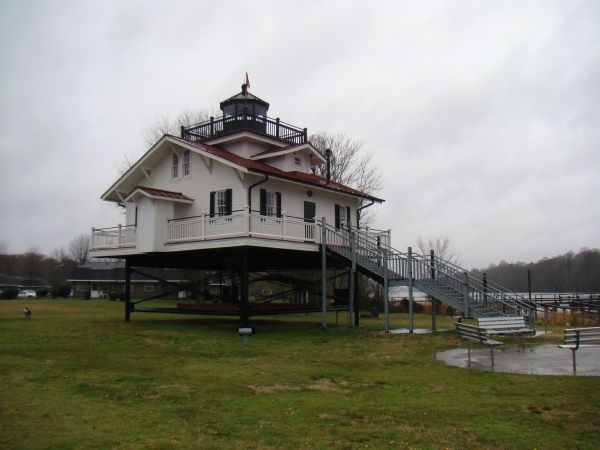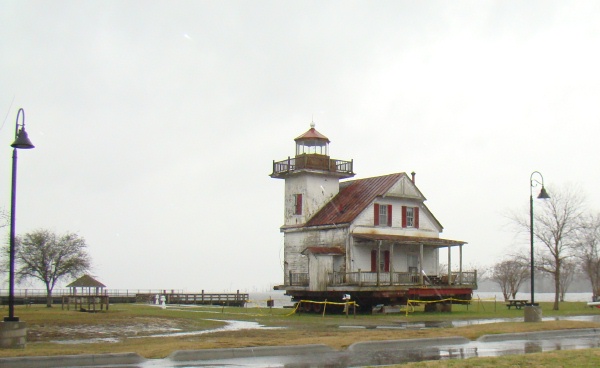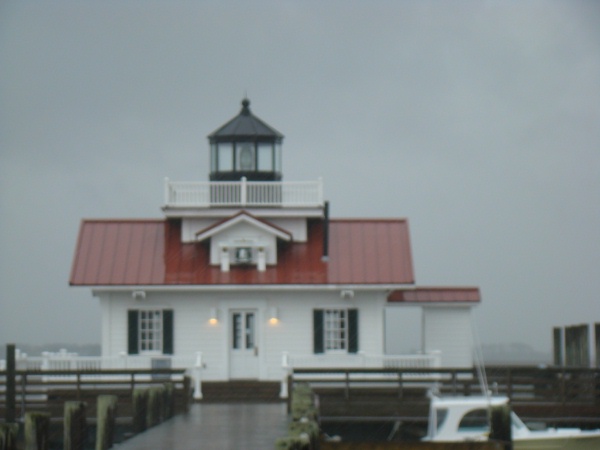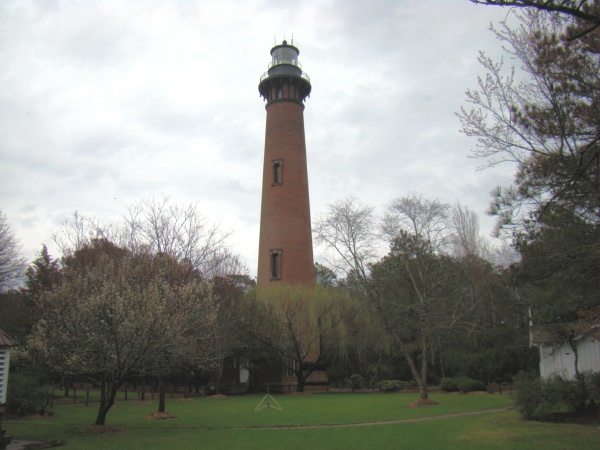We’d planned on traveling to Cape Hatteras on Friday, staying overnight near Ocracoke, and taking a flight on Saturday morning to see a number of offshore NC lighthouses including Cape Lookout, but the torrential rains started on Friday and Saturday’s forecast did not bode well for a flight. The dog-sitter needed to be rescued from our two 4-legged beasts so we couldn’t stay another day–Sunday was supposed to be glorious. So, we opted to leave on Friday and travel to Plymouth and Edenton, NC to see the Roanoke River 1866 Replica (Plymouth) and the relocated 1887 Roanoke River Lighthouse that replaced the destroyed 1866 lighthouse and the Roanoke Marshes Replica (Edenton).
Two Roanoke River Lighthouses served at the station located near the confluence of the Roanoke River and Albermarle Sound, 6+ miles NE of Plymouth, NC. The replica is modeled after the 1866 lighthouse.
The 1835 lightship placed near the mouth of the Roanoke River named “MM” had whale oil lights that showed through red, blue, and green lenses. The Confederates took control of “MM” in 1862 when Union forces invaded eastern NC and sailed it upstream to Plymouth. The ship was scuttled in the river during the war.
Work began on the Roanoke River Lighthouse which would replace the lightship when the conflict ended. The lighthouse was destroyed by fire in March of 1888, but was rebuilt and put back into service later that year. Ice floes continually acted on the spindly support legs of screwpile-type lighthouses and that occurred with this structure, causing it to collapse into the sound.
This replica came about when an agreement could not be reached with the heirs of the owner of the 1887 lighthouse. It was determined that a replica could be built for much less than the $1 million the heirs asked for the only surviving NC screwpile lighthouse. Work began in the fall of 2001, using plans copied from the originals that were located at the National Archives.
There is a strong possibility that the 1835 lightship may be raised and placed near the lighthouse.

After lunch at one of the local restaurants, we continued on to Edenton, NC and two of the three remaining lighthouses we’d see on this trip.
The second Roanoke River Lighthouse served from 1887 until the station was discontinued in 1941. The lighthouse was purchased in 1955 from the Coast Guard by waterman Elijah Tate with two other Albermarle Sound lighthouses for $10 each. Tate dropped two of the three lighthouses into the Sound while trying to relocate them. He sold the third one to his friend, Emmett Wiggins, a tugboat operator by trade. He “knocked away all of the pilings except those at the diagonal corners. Then I sank the Landing Craft Infantry that I used as a barge down far enough to float under the lighthouse. When I pumped the water out, the barge came up under the heavy wooden sills of the main lighthouse structure. As soon as I cut away the remaining piles, everything floated free and I sailed back to Edenton with my new home. The whole job took about 36 hours.” He placed the lighthouse on a piece of property he had purchased near the mouth of Filbert’s Creek.
Wiggins agreed to sell the lighthouse to the town of Plymouth, but he passed away in 1996 before a deed was signed. The heirs of the owner of the dilapidated 1887 lighthouse dropped their asking price to $225,000 in 2007 and sold it to the Edenton Historical Commission in May. The Commission paid $75,000 to move the lighthouse from the banks of Edenton Bay to Colonial Park in Edenton’s downtown waterfront area on May 23, 2007. NC’s one authentic screwpile lighthouse is to be converted into a maritime center. Its 4th-Order Fresnel lens was removed prior to the move and will be returned to the lighthouse when renovation is complete.

There was a system of 12 screwpile lighthouses that helped mariners navigate the complex system of sounds and waterways that lie between the Outer Banks and the NC mainland. The Roanoke Marshes Lighthouse has been reconstructed and stands just offshore from the town of Manteo on Roanoke Island.
This replica is the fourth to carry the name of Roanoke Marshes–three different structures were used at the station in Croatan Sound. The first lighthouse went into service in 1831; it lasted only eight years. Abandoned because it was in need of extensive repairs and the owner of the land on which the lighthouse had been constructed claimed title to the land.
The second lighthouse went into service in April of 1858. By 1876 the wooden support piles suffered significant worm damage and the lighthouse itself had been flooded on a couple of occasions. Deemed unsafe, work began on a third lighthouse that went into service in 1877. This lighthouse, a white, square structure supported by seven screwpiles that stood in 9' of water is the model for the replica lighthouse.
Decommissioned in 1955, it was suggested that the town of Manteo purchase the lighthouse and relocate it to the Manteo waterfront. However, a private citizen named Elijah Tate acquired the lighthouse with two other screwpile lighthouses in the area. The structure was cut from its foundation and palced on a barge to be transported to its new home. Not far from the original site, rough seas caused the lighthouse to topple off the barge and sink into the Sound. The effort to retrieve the submerged lighthouse was considered too great and the structure was abandoned.
Decades later the town of Manteo decided to build a replica as the centerpiece of their 1999 centennial celebration. Funding delays, Hurricane Isabel, US Army Corps of Engineers’ objections all contributed to pushing the completion date well beyond the centennial year. Finally dedicated in September of 2004, the lighthouse is a great addition to the waterfront.

Again, another lighthouse that we’ve seen, but years before I got wrapped up in Harbour Lights. We don’t even have an album-sized photograph of Currituck Beach Lighthouse–the picture we do have is a framed 8 x 10. Framed because it’s a stunning picture, but I didn’t think to get it in a 4 x 6 size. The lighthouse is open for climbing from Good Friday until after Thanksgiving. The grounds are not gated or fenced and Stan took numerous pictures.
Currituck Beach Lighthouse is the only natural brick construction of the five lighthouses of the Outer Banks, NC. The others are painted in striking black and white–vertical, horizontal, and checkered patterns. Currituck Beach LH is 162' tall and is on a foundation of stone and timber pilings that are laid 7' below ground. Over a million bricks were used for the tower. Illuminated for the first time on December 1, 1875, its 1st-Order Fresnel lens’ 20-second flash cycle still illuminates the sky every night.
This gorgeous lighthouse and its station buildings have survived being abandoned, vandalism, and the havoc nature can do over the years, and dirty politics in recent years. One of three lighthouses in NC open to the public. Over a million dollars has gone into restoring and maintaining the lighthouse and grounds. Well worth a visit–even when the station is closed.

That’s it. Spent most of Saturday driving through torrential rain all the way home. You don’t want to know how stressed both of us were by day’s end. The greeting we got from the dogs was worth every rain drop we plowed through. They’re still making like shadows when one or both of us makes a move to go outside–“not without me, you can’t go if I can’t go!!”
Hope you’ve enjoyed the trip. . . .
Sandy

